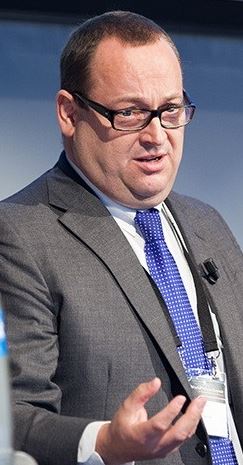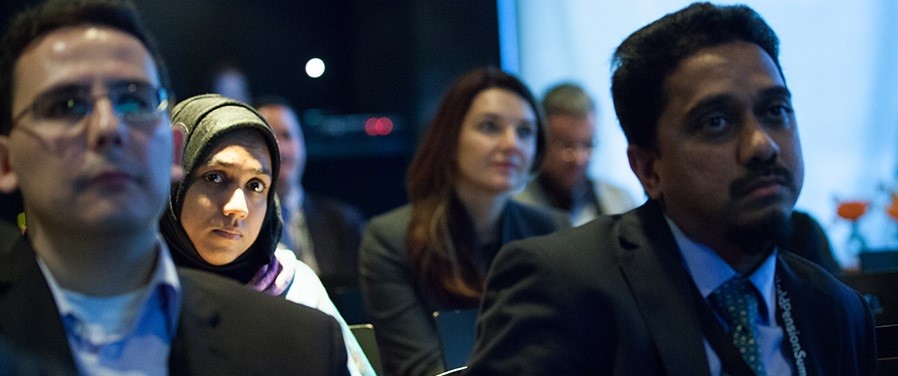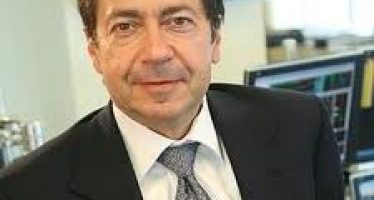Restoring Public Confidence: Industrialising Delivery of Pension and Retirement Solutions
 Over the past century, governments, as well as public and private sector pension and retirement providers, focused on expanding existing and introducing new systems with a core focus on payment of benefits. Strong investment performance limited the perceived need to focus on delivery and operational excellence prior to the global financial crisis (GFC). Governance solutions that are not fully aligned with the critical nature of pensions and the associated size of the system are more common than rare. And thus, Josef Pilger gives a strong plea for industrialisation of delivery of pensions and retirement solutions consequently restoring public trust. Josef works in EY’s Financial Services practice and has 20 years of strategic and operational experience in Asia-Pacific, Europe and the US. He is without a doubt a man with a mission.
Over the past century, governments, as well as public and private sector pension and retirement providers, focused on expanding existing and introducing new systems with a core focus on payment of benefits. Strong investment performance limited the perceived need to focus on delivery and operational excellence prior to the global financial crisis (GFC). Governance solutions that are not fully aligned with the critical nature of pensions and the associated size of the system are more common than rare. And thus, Josef Pilger gives a strong plea for industrialisation of delivery of pensions and retirement solutions consequently restoring public trust. Josef works in EY’s Financial Services practice and has 20 years of strategic and operational experience in Asia-Pacific, Europe and the US. He is without a doubt a man with a mission.
Josef Pilger will be addressing pension experts from around the world at the 5th WorldPensionSummit in The Hague on 5 and 6 November 2014. This Summit is the only worldwide platform for and by pension professionals.
Industrialising delivery of pension and retirement solutions
Q: What do you mean by industrialising delivery?
Industrialising delivery means that pension and retirement solutions are closing the gap to other financial services sub-sectors, taking a customer focus, enhancing governance and taking operational excellence to the next level. A customer-centric culture, systems and solutions, as well as effective engagement and communication, are the key pillars of industrialisation. With this industrialisation should come a focus on efficiency and effectiveness.
Q: Can you give me a few examples?
The interactions with employers, members and beneficiaries are mostly focused on payments and information exchange. In an era of bitcoin ATMs and the ability to do most things via your smartphone, the most prominent forms of exchange for pensions are too often still cheque and paper. Fit for purpose end-to-end process automation, electronic payments, electronic rollovers or employer self-serving are only a few examples that would make a fundamental contribution to industrialisation. I sat on an Australian Government working group to design such solutions, and the benefits are substantial. Empowering members with self-servicing platforms or integration into online banking are also good examples of the customer being put in the centre, which should, ultimately, reduce costs. I have been involved in designing and implementing a few of those solutions. They drive the “retailisation” and industrialisation of pension and retirement systems. Unfortunately, pensions and retirement have been seen by many as special or too complicated, limiting the impact of delivery innovation and industrialisation, which transformed many other industries.
Q: Why is this important now?
The GFC highlighted many pension and retirement challenges. Those challenges included sustainability as well as investment losses which generated widespread attention. It also raised public debate about member decision-making, governance and fee levels in many countries. This debate challenged confidence in pension and retirement systems. Confidence is critical in any long-form saving vehicle. Addressing sustainability challenges may take time to deliver tangible results, but fundamental improvements on these key dimensions of delivery will enhance the member experience. Existing delivery practices of using paper and manual payments in many countries offer significant opportunities, e.g., cost and fee reductions or member empowerment. Acting on these aspects now may support restoring public confidence. But, this is only half of the story.
Q: What is the other side of the story?
“Many pension and retirement systems are focused on restoring public confidence. Industrialisation helps in this process.”
Post-GFC, we see a fast-increasing popularity of solutions that depend on employer and member interest, decision and actions. The success of the introduction of member choices in existing mandatory systems, new voluntary systems or major changes to existing solutions and portability of existing assets depend on member and employer action. Recent examples include the introduction of choice of fund in Australia, partial portability in Hong Kong, and private pension products (PRS) in Malaysia. If members – and employers – do not feel adequately informed and empowered, their lack to act will limit take-up and retention. Limited take-up and retention impact providers, members and policymakers. Industrialisation is very important for this process, as much depends on members and employers.

Q: What benefits does industrialisation generate for members and employers?
We have seen quantitative and qualitative benefits for all key stakeholders: members, employers, providers and policymakers. Enabling better decision-making for members and employers increases confidence. For members, this means making better decisions and selecting options that are better aligned to their personal situation and risk profile. This is expected to lead to better investment performance and improved long-term retirement outcomes. For employers, this means less effort to fulfil their obligations, processing regular contributions – thus reducing “noise” in the system.
Q: What benefits does industrialisation generate for private and public providers?
“For providers, industrialisation means more satisfied and better informed members. Employers join or remain with that provider.”
A customer-centric approach puts members and employers in the centre. Information, products, services and solutions are designed “outside-in” to suit members and employers rather than providers. Reduced delivery costs means that providers have more flexibility to reduce fees to drive competitive advantage or add more service options. Short term, this comes at a cost; but long term, this investment pays off through higher satisfaction, retention and growth.
Q: What is your recommendation for policymakers and providers?
Leading policymakers and providers realise that good policy and strategy are not enough to inform, win and retain members and employers. Technology progress and the need to proactively respond to confidence challenges post-GFC made industry executives realise that the business issues and challenges for pensions and retirement are not unique to other industries or government social services.
Leading policymakers and providers add the dimension of “delivery” to their systematic rebalance of adequacy, sustainability and investment performance. They take a leading “delivery vision 2020” from innovative consumer or financial services organisations and apply this to pension and retirement delivery. This means adjusting culture, capabilities and infrastructure. Post-GFC pressure and the shifting balance of power and reliance on member actions makes industrialisation a priority to act now.
Q: Do you see parallels in the industrialisation of delivery in different international zones?
The focus on industrialisation generally grows as systems mature. It is more common in defined contribution systems, as they more often focus on improving efficiency and effectiveness rather than simply reducing cost. When pension and retirement assets per customer grow, three aspects often occur: a) customers pay more attention and become more demanding, such as in Australia; b) competition increases, and providers become more innovative, such as in the UK or US; and c) the industry becomes more transparent, and the public pays more attention to fees and charges which creates pressure to differentiate, such as in Hong Kong. Currently, there is no one leader that gets all aspects right, but we see many good examples around the world. Two aspects we can learn from these examples.
Defined contribution systems in many emerging or fast-developing countries without existing pension and retirement legacies appear much better prepared and focused on industrialisation than mature markets or defined benefits systems. The more paternalistic nature of the “traditional” employee benefits and defined benefits may be one reason. The second point is focus and listening to customers. Customers have little patience with traditional pension and retirement processes in a world where most things become digital and put them in the centre.

Q: What is the influence of globalisation and ageing on this process?
We are seeing a fast-increasing globalisation of pension and retirement beyond investments. Industry and policy executives are increasingly demanding insights and experience from other markets and systems. They take these insights and incorporate them in their domestic systems and solutions. Automatic enrolment or employer-centric contribution collection platforms are only two examples that currently conquer the defined contribution world.
Two aspects of the demographic transformation and ageing will accelerate this process.
“Older people with more pension and retirement assets in their account prefer more control. The strong growth of the self-managed superannuation sector in Australia is a vivid example.”
Most of the younger generation has little experience with the luxury of defined benefits autopilot. Instead, they prefer control and informed decisions from the palm of their hand. To better engage them to act, particularly in voluntary systems, we need to “industrialise” like most other industries.
Q: What would you say is your lifetime achievement so far, what makes you most proud?
My two boys make me proud. The fact that my wife taught them to put money away for later is hopefully a lifetime achievement. For my youngest, this is still work in progress. His savings horizon generally is the next big trip to the ice-cream shop, but we all started with small steps.
Q: What drives you? What is your absolute passion for life?
I like to make an impact to people’s lives. Working at EY allows me to combine my personal drive with commercial interests. As an organization, we are committed to building a better working world. For our global pension and retirement team, we adjusted that to building a better retirement world. In my role, I help governments, as well as public and private sector pension funds and providers, to build, improve, expand and innovate their pension and retirement systems and businesses. This will build a better retirement world for many people globally. My contribution hopefully helps these people with better financial well-being during their retirement.
Q: What is your ambition for the next 10 years?
In many countries, we cannot necessarily agree on the best solution, but I believe we debated pension and retirement policy for long enough. I think we need to rebalance our focus between policy and delivery. I’d like to spend the next decade on helping policymakers, as well as public and private sector providers, with this rebalancing process. This will build a better retirement world for all stakeholders.
About Josef Pilger, Asia-Pacific Pension Practice Leader, EY
 Josef works in EY’s financial services practice and has 20 years of strategic and operational experience in Asia-Pacific, Europe and the US. He has worked in several strategic and operational industry and advisory roles, servicing governments and leading organisations in the public and private sectors and in the life insurance, asset management, wealth management and pensions and retirement industries in Asia-Pacific, Europe and the US.
Josef works in EY’s financial services practice and has 20 years of strategic and operational experience in Asia-Pacific, Europe and the US. He has worked in several strategic and operational industry and advisory roles, servicing governments and leading organisations in the public and private sectors and in the life insurance, asset management, wealth management and pensions and retirement industries in Asia-Pacific, Europe and the US.
Analysing, designing and refining pensions, retirement and broad social insurance policy and policy options are Josef’s main focus, working closely with governments and regulators across Asia-Pacific.
He works with many leading public and private sector pension and retirement providers along the value chain, including pension funds, life insurers, retail banks, asset managers and wealth managers, across Asia-Pacific to protect, improve and grow their business. He provides strategic and operational advice in areas such as strategic direction, funding, growth, performance improvement, distribution and business transformation programs.
The views reflected in this article are the views of the author and do not necessarily reflect the views of the global EY organization or its member firms.
WorldPensionSummit 2014, 5–6 November, The Hague
WorldPensionSummit is the only global platform for and by pension professionals.
Meet your peers and share the latest innovative ideas for a sustainable pension provision. The 2014 theme is: Financing Pensions | new roles – new responsibilities. The WorldPensionSummit 2014 offers key analysis, insights and ample room for discussion amongst peers. Meet top experts and key authorities in the field of retirement management, pension fund strategy, social security and employee benefits. Learn from key questions and actual best practices in Pensions. The best global networking opportunity with over 300 pension professionals from 45 countries! Register at: www.worldpensionsummit.com. Use special conference code for 20% discount: MEDIA2014WPS20
You may have an interest in also reading…
Driving Change: Empowering Inclusion and Innovation at Boursa Kuwait
At Boursa Kuwait, inclusion, diversity, and innovation drive the mission to transform Kuwait’s capital markets into a platform for opportunity,
Greece on the Mend: Investors Find New Land of Opportunity
The severely battered Greek economy is on the mend. A rebound may even be in the works. The same hedge
Africa Enters an Age of Optimism
The upcoming UN General Assembly (UNGA) in New York presents an opportunity for world leaders to assess the drivers of



















































































